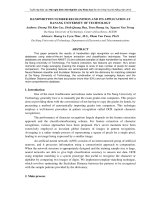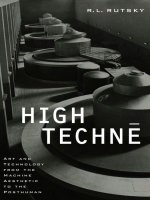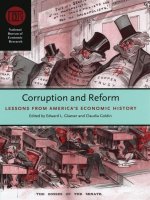Margaret derry ontarios cattle kingdom purebred breeders and their world, 1870 1920 university of toronto press (2001)
Bạn đang xem bản rút gọn của tài liệu. Xem và tải ngay bản đầy đủ của tài liệu tại đây (13.66 MB, 238 trang )
O N T A R I O ' S CATTLE K I N G D O M
Purebred Breeders and Their World, 1870-1920
www.pdfgrip.com
www.pdfgrip.com
ONTAR+O'S
CATTLE KINGDOM
Purebred Breeders
and Their World,
1870-1920
Margaret Derry
UNIVERSITY OF TORONTO PRESS
Toronto Buffalo London
www.pdfgrip.com
www.utppublishing.com
© University of Toronto Press Incorporated 2001
Toronto Buffalo London
Printed in Canada
ISBN 0-8020-4866-8
Printed on acid-free paper
National Library of Canada Cataloguing in Publication Data
Derry, Margaret Elsinor, 1945Ontario's cattle kingdom : purebred breeders and their world, 1870-1920
Includes bibliographical references and index.
ISBN 0-8020-4866-8
1. Cattle - Breeding - Ontario - History. 2. Cattle breeders - Ontario History. 3. Beef cattle - Ontario - History. 4. Cattle trade - Ontario History. I. Title.
SF+96.C2D47 200++++++++++++++++++++++++++++
Frontispiece: Group of Thoroughbreds.
From Report of the Ontario Agricultural Commission, vol. 4, 1880.
University of Toronto Press acknowledges the financial assistance to
its publishing program of the Canada Council for the Arts and the
Ontario Arts Council.
This book has been published with the help of a grant from the Humanities
and Social Sciences Federation of Canada, using funds provided by the
Social Sciences and Humanities Research Council of Canada.
University of Toronto Press acknowledges the financial support for its
publishing activities of the Government of Canada through the
Book Publishing Industry Development Program (BPIDP).
www.pdfgrip.com
Contents
Preface++vii
Acknowledgments
xiii
1 Ontario and Agiculture, 850-+920+++
2 Livestock Expertise: Ontario Purebred Breeders
and Their World 14
3 Purebred Breeding, Cattle Production, and Regulation 53
4 The Relationship of Purebred Breeders to the
General Beef-Farming World in Ontario 86
5 Purebred Breeding and Dairying 107
6 Ontario Cattlemen and Canadian Beef Farming 116
7 The Ontario Beef Farmer and the Meat Industry 133
8 Conclusion 149
Epilogue 156
Notes6+163
Biblography++1+1
Ind+x++15
Plates follow page 29
www.pdfgrip.com
This page intentionally left blank
www.pdfgrip.com
Prea+ce
This book is about the world of Ontario purebred cattle breeders
between 1870 and 1920 and the impact of their work on the Canadian
beef cattle industry specifically and national dairying tangentially. While
the topic appears to be a specialized one, in fact it offers information on
cattle farming generally and even explains something of the dynamics
of agriculture itself. My study of purebred cattle breeders in Ontario is
intended not only to provide knowledge about specific aspects of livestock farming, but also to introduce the reader to the broaderop++++
how the world of agriculture worked. One of the chief difficulties in
understanding the dynamics of the rural past is grappling with the fact
that it presents such a diverse picture. In any exploration of agricultural
history the scholar is confronted with a bewildering array of social, economic, and cultural characteristics, making it hard to understand agricultural thinking, to find commonality of patterns, or to appreciate the
occupation in a comprehensive way. This problem is especially exasperating because farming was the occupation of so many Canadians for
most of the country's history. How can we grasp the diverse natur o+f
agriculture in relation to the underlying homogeneity implied by farming's ubiquitous presence? It seemed to me that the story of a particular
farm enterprise could illustrate how underlying patterns existed within
the diverse warp and weave of agriculture's complex fabric. Characteristics of agricultural thinking, or expertise, in relation to the practice +f
farming could be discerned.
This history of Ontario purebred cattle breeding and its relationship
to cattle production generally in the late nineteenth and early twentieth
centuries is approached in a rather unusual way: I tend to focus on the
herds - purebred and otherwise - as much as on the people who ere-
www.pdfgrip.com
viii
+Prefae
ated them. My reasons for doing so are twofold. First, the livestock can
tell us what people thought, because the animals were living examples
of cattle-breeding theory. By addressing cattle characteristics, we can see
how both purebred breeders and farmers hoped to market their product, and that these individuals could strategize their production in complex ways, via breeding techniques. When we look at cattle-breeding
methods, for example, it becomes apparent that by the 1890s the production of beef generally tended to mirror two patterns: attituds o+f
farmers to purebred breeders' stock and a concurrent intensification
of dairying activities in Ontario. It is significant that beef production
reflected certain breeding methods and that beef farming increasingly
became a by-product of dairying; the two patterns explain what some
agricultural practices were and why these practices ex+sd. The be+ef
and dairy industries had become linked far more closely in 1899 than
they had been in 1879. A farmer in 1899 might describe his beef income
as part of 'dairy' income, or as an added bonus to dairying. The purebred industry played a role in that linkage, and as a result it is difficult
to fully understand either general beef farming or dairying without an
appreciation of purebred breeding.
The second reason that a focus on the livestock is important is that
any appraisal of an agricultural industry should take into account the
capability of the animal or plant to provide the marketed product.
Scholars have not given enough attention to the role these biological
underpinnings played in historical agricultural output. The cheese
industry (a major nineteenth-century sector of dairying in both the
United States and Canada), for example, is usually assessed by focusing
only on cheese manufacture - be it farm or factory - without any appreciation of the role played by the generators of milk used for cheese namely, the cows. Since cheese was just as much the production of cows
as of factories, at least some attention should be given to the characteristics of the animals and how these shaped the industry. By indicating how
the animals were physically changed for meat production through purebred breeding, this review of the purebred beef cattle industry shows
how farmers used the beasts that provided beef. I aso assess why farmr+s
chose whether or not to use the purebred stock for that purpose, and
how those shifts interacted with marketing systems. I hope to reveal how
biological factors embedded in cattle, and how purebred breeder and
farmer assessments of those capabilities, influenced the agricultural output of beef. The herds embodied forces that were not necessarily compatible: different visions of people and biology.
www.pdfgrip.com
Preface+
i+
Specific topics emerge in this story of purebred breeders and their
world. One particularly important one is the process of innovation
adoption with respect to animal breeding. In spite of the diverse conditions on farms, an underlying cleavage exists in this story of purebred
breeders and the larger agricultural world. Farmers faced experts over
the acceptance or rejection of breeding theories. Various scholars in the
United States have noted farmer reluctance to use information technology from 'off the farm' befor+++++++++++++++++++++++++++++
information between 1870 and 1920, then, are especially interesting
because they reflect approaches to change in a transitional period. How
did farmers use biological technology? Why would farmers decide no
longer to rely on their own judgment, but rather, with respect to livestock biology, to import outside technology? Questions of this nature
cannot be answered without reference to expert discourse. It is known,
for example, that the farming press was the most influential vehicle by
which new agricultural knowledge became widespread.2 We can learn
from journals, then, about the early process of how farmers assessed biological innovation from off the farm.
Another topic that arises in this study is the fight against human and
animal disease. The story of the purebred cattle breeders' world and its
relationship to general cattle farming tells us about developing medical
opinions in the nineteenth century, about control of disease, and about
the relationship between human and animal illness. In the process we
learn how veterinarians, bacteriologists, and doctors worked with each
other. Cattle diseases were intimately linked with the evolution of state
development, with regulation, and with the economy.
Two closely related issues are the development of regulation for all
purebred breeding in Canada and the evolution of breeding methodology. The concept of herd books and control of the documentatio +of
purebred stock arose in these years and dovetailed with shifting ideas on
breeding methods. It is important to understand herd books and breeding theory for farm animals in the 1870 to 1920 period for two particular reasons. First, it was within this time frame that the eugenics
movement - the drive for greater 'purity' and improvement of the
human race - took place, and we do not know enough about the relationship between ideas on the breeding of animals and those on the
breeding of people. Second, the breeding methods applied to animals
that we see today - not only in the production of farm stock, uo++f
house pets as well - evolved between 1870 and 1920. Many nineteenthcentury animal-breeding theories are still with us today, and therefore
www.pdfgrip.com
x
+Prface
expert discourse of the nineteenth century has much to say about the
way animals are bred in the present. Modern genetics has only just
begun to influence how to breed good livestock or pets. That science,
more in the form of quantitative and population genetic theory than in
Mendelian genetics, has started to make it easier to achieve desired
results. Even so, the breeding of animals is still to some degree an art.
Indeed, it could be argued that the views of farmers and purebred
breeders on animal breeding in the late nineteenth and early twentieth
centuries would come to form the core of what the modern approach
has become.
Economic implications emerge in this story as well. Examples are the
linkages of Ontario's purebred industry to the nation, Ontario's general
beef cattle production from a national point of view, and the functioning of the beef cattle market and its relationship to both consumer and
cattle producer. One economic pattern that is explored is the east-towest linkages of the beef cattle industry. The production of Canadian
beef cattle did result from west-to-east linkages, but not the ones that are
commonly held to be true. It has been stated, for example, that by the
1880s western cattle came to Ontario to be fattened for slaughter. They
did not in fact do so until after 1920. In contrast, in the late nineteenth
and early twentieth centuries the situation was the reverse - Ontario
stock went west for feeding. Economic implications also emerge in an
assessment of the impact of product quality on the industry. This study
explains product quality and shows how that is of crucial importance to
any economic understanding of the industry or of farmer inputs and
outputs.
Because no discussion of the Ontario situation is complete without
reference to the province's position relative to that of other provinces, I
look into what was happening across Canada with respect to the purebred industry and also beef cattle raising. I assess the relative positions
of the provinces in order to achieve an understanding of the national
picture. My aim is to comprehend the relationship of the provinces to
the whole, not to present an in-depth analysis of the industry in each
region. Provincial and Dominion government documents are used as
the main sources to do this. It is perhaps worth noting that little written
in French turned up from these sources on the Quebec circumstances.
French-Canadian farmers were far more likely to practise dairying, not
beef farming, in a commercial way, and that fact probably at least
partially explains the relative lack of French-language material on b+ef
cattle. The purebred situation in Quebec provoked writing by French-
www.pdfgrip.com
Pr+e++
i+
Canadian experts in the English language, a phenomenon discussed
later in this book. Quebec Department of Agriculture reports were written in French but, like other provincial governments in the late nineteenth century, they assessed cattle affairs by using only Dominion
statistics. Government documents showed that beef cattle raising was
not critical to Quebec or the Maritimes either, and also that my story,
from a national point of view, was centred on Ontario and its relationship to western Canada, particularly Alberta. For this reason, Alberta
cattle ranching and farming received more attention from me than the
beef industry in provinces other than Ontario.
Some issues that surface in the book beg more extensive research
than this study can give. Many of these topics are related to the industry
most closely affiliated with beef cattle farming - the meat industry. This
book deals with matters relating to live cattle, not to dead meat. The
impact of transported dead meat on the movement of live cattle is not
investigated. The meat trade in its entirety needs to be better understood before we see how it affected cattle farming. I hope that this work
stimulates more in-depth analysis of the beef packing industry (which
was totally separate from the pork packing industry) and its relationship
to central stockyards, and also of the regulation of the meat industy. We
do not comprehend the beef processing industry well enough to appreciate the ultimate driver behind both industries: patterns of consumption. Our understanding of the way farms worked with the meat
industry to fulfil consumer needs, and the process of consumption itsl+f
as it applied to different social groups rather than per capita, would be
greatly enhanced by a better understanding of many aspects of the meat
industry.
A few comments beyond what has already been said about sources
used for the research of this book might be added here. While I utilized
statistical material, I relied more heavily on expert discourse to tell my
story. The views of the experts, of course, represented only what these
individuals thought. Farmer dialogue that took place over the farm
fence on subjects such as livestock and expert opinions would probably
offer a different point of view, but unfortunately we do not have records
of these talks. Expert discourse emerged not just in the farm press, but
also from other sources. A very significant one was government documents. Sessional Papers of governments at the provincial and Dominion
level and reports of provincial and Dominion Departments of Agriculture supplied valuable material on circumstances in Ontario and in
other provinces. Breeder association reports and contemporary works
www.pdfgrip.com
xi+
+Prface
on animal breeding and farming techniques provided wonderful
sources as well. Monographs on the historical development of various
breeds offered another perspective. It was possible to trace the excitement that purebred breeders must have felt over developments in their
world. Poring over herd books and .registration lists was less interesting,
but the activity did teach me how to link types of stock to certain groups
of people in a way that would be impossible to understand otherwise.
The letters of Arthur Johnston, Ontario Shorthorn breeder, were invaluable. Information on markets, breeding, the structure of breed associations, relationships with other breeders, international implications, and
difficulties with quarantine emerged in this breeder's personal discourse. Reading them also revealed the history of some individual animals. Their stories added colour to the research process, and I hope as
well to the finished book.
My story of purebred cattle breeders and their world reveals strategies
to control markets, and the process of innovation adoption through particular emphasis on animals as cultural texts. The animals reflected what
experts and farmers thought about agricultural practices and market
control. Cattle also show us how agricultural technology was inevitably
meshed with biology. In spite of the diversity and complexity that agriculture presents with respect to beef cattle farming, then, we do see definite patterns in the industry. It is my hope that this study of Ontario
purebred cattle breeders and their impact on the general cattle-farming
world will illustrate at least one aspect of the dynamics of agriculture.
www.pdfgrip.com
A cknowledgments
Work that was both practical and academic went into the writing of this
book. The study developed initially from farm experience as a purebred
breeder and from academic work that in its earliest form was a PhD thesis. On the practical side, I learned a great deal about present-day agriculture generally and cattle breeding particularly after my husband,
children, and I decided to become breeders of purebred beef cattle. It
was quite an experience for city people! From farmers and fellow purebred breeders of cattle, from show judges and the 4H leaders who
taught our children about the practical aspects of farming activities,
over the years I became aware of a totally new world. On the academic
side, when I returned to graduate school in the doctoral program at the
University of Toronto's Department of History, I gravitated quite naturally to the subject of historical cattle production for my dissertation.
History and geography scholars at the University of Toronto helped me
see other farming issues outside the practicalities of agricultural work.
From Ann Robson I became aware of the underlying developments in
Britain that were the basis of livestock breeding in Ontario. From Jim
Lemon I learned agricultural practices of the past, especially in the
United States. From Carl Berger I came to appreciate the larger intellectual world of the late nineteenth and early twentieth centuries in both
Ontario and Canada. From my doctoral supervisor, Craig Brown, I
learned the most. He supported me throughout the program and
offered clear, helpful advice while I was writing my dissertation. The
appraisal readers for thesis defence, Ian Radforth of the Universit +of
Toronto and Harriet Ritvo of the Massachusetts Institute of Technology,
supplied insightful comments on the completed dissertation.
I found when I wrote the dissertation that there was a paucity of infor-
www.pdfgrip.com
xiv
Acknowledgments
mation on the agricultural history of Ontario in the late nineteenth and
early twentieth centuries, especially that relating to the livestock industries. While a purebred breeding aspect of cattle farming was not the
largest sector of that livestock enterprise, I came to see the evolution of
purebred breeding as central to wider developments within that world.
When Gerry Hallowell of the University of Toronto Press invited me to
submit a manuscript based on the conversion of my thesis to a book,
I chose to emphasize the story of purebred breeding to a greater
degree than I had in the thesis. In that process, it became obvious to
me that cattle production in Ontario and Canada at the end of the
twentieth century could be understood more comprehensively when
late-nineteenth-century patterns were more fully understood. I also
found that patterns in all livestock production (and the breeding of pet
animals, for that matter), not just cattle improvement, were made
evident this way.
This book has been published with the help of a grant from the
Humanities and Social Sciences Federation of Canada, using funds provided by the Social Sciences and Humanities Research Council of Canada. A number of people helped me bring the manuscript with its new
orientation and information to completion. Gerry Hallowell, Emily
Andrew, and Jill McConkey of the University of Toronto Press aided me
with submission for publication. Frances Mundy and Wayne Herrington
helped see the book through to completion. I was fortunate in the peer
review process to have the readers that I dd for th Universty +++f
Toronto Press and the Aid to Scholarly Publications Program. Anonymous reviewers provided insightful comments and many helpful recommendations, which in the end greatly improved the book. Discussions
about cattle with fellow purebred breeders made me understand more
comprehensively the issues that earlier breeders had faced. One farmer,
Dave Jackson, read the manuscript and offered useful comments. After
revisions at this stage, the manuscript was reviewed by my peers Shelley
McKellar and Allison Kirk-Montgomery, PhD candidates in the Deparment of History, University of Toronto. Their ideas and encouragement
resulted in an immensely improved book. Michelle Leung supplied me
with valuable material that I had been unaware of. My husband, Douglas
Derry, who is a chartered accountant, spent many hours reading the
manuscript and gave sound advice on overall themes and the economic
arguments that I made. And again Craig Brown supplied wonderful support. He reviewed the manuscript and provided many comments on the
structure, style, and content of the new work. Without the input of all
www.pdfgrip.com
Acknowldgments+
++
the above people, this book would not have been possible. I thank them
all most sincerely.
This monograph is but an introduction to the larger agricultural
world of the past, and I hope that historians will see from the work how
much more there is to learn about historical farming. I also hope that
present-day farmers and breeders will enjoy learning about what happened to their counterparts in days gone by, and will see how much has
changed and how much remains the same in the world of agriculture.
www.pdfgrip.com
This page intentionally left blank
www.pdfgrip.com
O N T A R I O ' S CATTLE K I N G D O M
Purebred Breeders and Their World, 1870-1920
www.pdfgrip.com
This page intentionally left blank
www.pdfgrip.com
ONE
Ontario and Agriculture, 1850-1920
'Old Bossy is easily the most important of all lower animals upon the
green-carpeted footstool of the Great Creator,' stated A.C. Wood, a popular, early-twentieth-century writer who had been raised on an Ontario
farm. He went on to say that 'there is more attention of++++++++++++
books than any other animal, bar none' and that 'artists are forever putting her into their pictures, too, and all her comings and goings are
pleasurable to behold.'1 The appreciation that this Ontario author had
for cattle was indeed justified. By 1870 cattle were bestowing significant
financial benefits on Ontario farm families through their dual production of dairy and beef commodities. Between 1870 and 1900 the number of stock on the province's farms doubled as farmers tried to
capitalize on the wealth generated by cattle.2 Purebred cattle breeders
played an important role in the way the cattle industry developed, and
this book describes the work of the breeders and their relationship to
beef farming generally. But the story makes more sense when seen
against a background shaped by many forces. The purebred industry,
and cattle farming generally, developed within a provincial, national,
and international framework, with both non-agricultural and agricultural forces. This chapter briefly explores certain aspects of that environment: namely, agriculture and the nation, Ontario's position within
both, Canada's export trade patterns, the agricultural situation in
Ontario from 1840 to 1870, and general agricultural changes in Ontario
between 1850 and 1920.
Agriculture represented 40 per cent of the national GDP in 1870.
While the role of farming declined in the national economy between
1870 and 1920, agriculture still formed an important sector of the GDP
in 1920 at just over 20 per cent.3 Ontario was clearly a major agricultural
www.pdfgrip.com
4
Ontario's Cattle Kingdom
producer within the nation in the late nineteenth and early twentieth
centuries. At Confederation in 1867 Ontario had the largest share of
income devoted to agriculture in the country. Although the province
led the nation in manufacturing output per capita, its relative position
to agricultural output per capita was even stronger.4 Average farm
incomes in Ontario were also high relative to those in other parts of the
country. For example, the average Ontario farm income in 1870 was
more than twice that in Nova Scotia.5 Per capita income was lower in
eastern Ontario than in the western section of the province; indeed, this
western section provided the highest income earned from farming in
the country. Within the national framework Ontario held an important
position with respect to agriculture related to cattle production as well.
In 1870 over 50 per cent of the nation's stock was located in Ontario,
and as late as 1920 the province still maintained over 30 per cent of the
nation's stock.6 Farm commodities produced from Ontario cattle were
aimed at both domestic and foreign markets. The export sector commanded the interest and attention of contemporaries, even though that
aspect of the cattle industry was not the largest segment of the cattle
economy. Contemporary concern with the export arm makes it particularly important that we first understand how Canada and Ontario functioned, above and beyond the cattle industry, in the general econmy o+f
the Western world.
All export aspects of the economy were built on the nation's relationships with two countries: Britain and the United States. Canada's main
export trading partners after 1867 were first Britain and then the
United States. Trade with the United States remained strong in sp+ +of
the abrogation of the Reciprocity Treaty in 1866, while more tan ha+lf
of Canada's imports came from Britain. Within this triangle, all three
nations experienced the general economic growth that prevailed in the
Western world. In 1873 world recession set in, and many countries
moved to greater protectionism (most notably, as far as Canada was concerned, the United States). Although recession lifted in 1879, the Canadian economy fluctuated until 1896. Imports exceeded exports in that
period, but trade deficits were insignificant because they were compensated for by British capital investments. Between 1873 and 1896 trade
patterns with Canada's two major trading partners shifted. Exports to
Britain climbed, and those to the United States fell. At the same time
Canada began to import more extensively from the United States.
After 1896 Canada benefited from the general economic boom experienced by Western nations. Canada's exports grew steadily, in spit o+f
www.pdfgrip.com
Ontario and Agriculture, 1850-1920
5
persistent protectionism from the United States, as British and American markets demanded agricultural products and prices rose. The
growth of British imperial sentiment and of attempts at imperial solidarity, through schemes such as preferential imperial tariffs in the late
1890s, helped fuel general optimism for the nation's economic future.
In 1913 world recession again surfaced. Recovery in Canada was encouraged by lower protectionism from the United States and by the outbreak
of the First World War in 1914, which also shifted the export economy.
War and adjustment to peacetime brought a basic move in Canada away
from economic dependence upon Britain to economic dependence on
the United States. It was against this international backdrop that the
agricultural export trade, and cattle farming generally, was practised in
Ontario between 1867 and 1920.
The post-1867 Ontario cattle industry evolved within a shifting agricultural situation within the province. By 1867 farming in the province
had undergone modifications from the earlier colonial period. The
relationship of wheat cropping to other farming endeavours changed as
wheat became less important. Wheat production had been particularly
significant between 1840 and 1860, and that fact has aroused considerable historical debate. Early scholars viewed wheat as the staple that
drove the economic engine of the province after 1840. It has been suggested many times that Ontario's economic growth resulted from the
province's status as a major wheat producer and exporter between
roughly 1840 and 1860. It has also been assumed that Ontario farmers
largely ignored livestock farming. More recently Mclnnis and McCalla,
who made a number of studies of Ontario agriculture at mid-century,
have shown otherwise. Their work reveals that wheat was important, but
it was not a staple (a great deal of the product was exported to Quebec
and not outside the nation), and at no time could it be said that wheat
was cultivated at the expense of other farming endeavours. Mclnnis
revealed, for example, that in the heart of the wheat-producing region
of Ontario, only about 25 per cent of the farm land was planted in wheat
at the height of the wheat era. Looking at Peel County, which was the
most prosperous farming area and most heavily committed to wheat, he
made clear that the county was above average in its stocks of animals
and generated an output per acre of animal products that was only
slightly below provincial average. Mclnnis believed that livestock products played just as important a role in the functioning of the farm economy as wheat.7 However, although livestock raising might have been
widely practised in Ontario by 1851, it is fair to point out that wheat still
www.pdfgrip.com
6
Ontario's Cattle Kingdom
played a particularly significant role in the farm economy. Wheat produced the most cash income for farms. Mclnnis's work suggests the
importance of livestock to the farm economy, but at the same time his
analysis of the 1861 census implies that wheat held a unique position in
the economy because of its special ability to generate income. He found
that farms were more likely to produce a surplus of wheat than any
other commodity - suggesting that wheat was more ikely than any other
commodity to provide income for a farm.8 It seems evident that livestock was essential for local trade (and for home consumption), but
before 1860 it was not a cash generator of the same significance as
wheat.
Over the first half of the nineteenth century, wheat yields per field
declined, thus decreasing potential income. Yields had been as high as
thirty to forty bushels an acre on recently cleared fields.9 By 1851 about
90 per cent of fall wheat planted resulted in a crop averaging sixteen
bushels an acre in Canada West, with only three of forty-two counties
producing more than twenty bushels an acre.10 The simple crop rotation method used by colonial farmers for wheat production - wheatfallow-wheat and known as 'naked fallowing' - partially caused these
declining returns from the fields. Naked fallowing reduced soil fertility
because it failed to return nutrients to the land. Lower crop yields also
resulted from the natural aging of land newly cleared of trees. Early
fields displayed a heightened fertility because removal of tree covering
results in abnormally high soil productiveness. The drop in crop yields,
then, reflected a return of the land to normal conditions as well as the
effects of naked fallowing. Because contemporaries were not aware that
tree removal changed soil capabilities, experts blamed the dramatic
decline of field productivity on naked fallowing alone. Consequently
farm journals bemoaned the practice.
Experts preached the values of an agricultural system that they
believed would correct the evil of soil exhaustion caused by the rotation
practice. This system was known as 'mixed farming,' or 'scientific farming,' and was founded on the principle that wheat cultivation should go
hand in hand with livestock production and the planting of fodder
crops. The symbiotic relationship between wheat and animal husbandry
was based on the theory that better wheat yields would result from rotation systems that provided nutrients to the land, as well as fertilizatio +of
the soil by animal manure. However, because the local market for livestock in Canada West before 1850 generated just small amounts of cash,
the only farmers who emphasized animal husbandry, as well as cropped
www.pdfgrip.com
Ontario and Agriculture, 1850-1920
7
wheat, were those with additional income from off the farm.11 Mixed
farming with substantial income potential would not begin until there
was a larger market for livestock products. For farmers to find mixed
farming worthwhile, it had to pay.
By 1870 the profitability of mixed farming had improved because livestock commodities, and more particularly cattle products, had found a
foreign market. When the Civil War broke out in the United States in
1861, new international market opportunities that were not in wheat
developed for Canada West farmers. The northeastern states were able
not only to meet their own demand for wheat, but also to export millions of bushels to Britain during the war.12 These states, however, were
not able to supply their own need for beef. The war cut off the connection between western cattle-producing areas and the eastern urban consumption centres.13 The result was a weak market in the northeastern
part of the United States for Canada West wheat, but a good market for
beef catde. Canada West farmers responded to this situation by shifting
their agricultural practices to bring them more in line with mixed farming theories, through a new emphasis on livestock production that was
directed particularly at the raising of beef cattle.14 The American market for Canada West catde products continued after the war, and even
survived the 1866 abrogation of reciprocity. In 1870 Canada exported to
the United States over one hundred thousand head of cattle, almost all
of which had come from Ontario.15 On the basis of Urquhart and Buckley's figures in+++++++++++++++++++++++++++++++++++++++++++++
on internal cattle movements in Canada (described in more detail later
in this book), it is possible to state that numbers exported represented
at least 40 per cent of the province's beef cattle sold for meat that year.
Clearly an export market motivated farmers to raise more stock than the
domestic market could handle. In the years after 1870 Ontario would
find a lucrative market for live cattle to varying degrees in Britain as well
as in the United States. From 1880 to 1900 approximately 20 per cent of
the beef catde sold by the province's farmers was exported.16 A greatly
expanded home-demand made the export market less significant by
1900 than it had been in 1870, but it was the early exportation of cattle
that triggered both the rapid development of Ontario's beef cattle
industry and an exaggerated concern with the export sector of the catde industry. Trade with the United States in the 1860s set the whole process in motion.
Even though farmers were more concerned after 1870 with beef (and
other livestock) production, in the present age of intense, specialized
www.pdfgrip.com
8
Ontario's Cattle Kingdom
farming it is worth emphasizing that until the end of the period under
study farmers continued to produce wheat as well as livestock. It was a
reorientation of value emphasis that had taken place. Initially because
of its export potential and later as a result of domestic demand as well,
animal agriculture became a cash-generating force to be reckoned with,
and therefore it commanded as much respect as wheat. But mixed farming continued after 1870 to represent the raising of both wheat and livestock. By 1921, of approximately 177,000 farmers in Ontario, about 300
practised dairying to the exclusion of wheat production, and some 600
emphasized livestock farming by devoting themselves solely to the raising of sheep, cattle, or horses. Most of the beef cattle production in
1921 resulted from the husbandry of Ontario's mixed farmers, who
made up 99 per cent of the province's agricultural producers.18 Farming in Ontario from 1870 to the 1920s, therefore, consistently reflected
that symbiotic relationship between wheat and livestock/fodder crop
production that was essential to the system of mixed farming and advocated by agricultural experts.
It is unclear whether farmers and agricultural experts agreed on the
strategy behind this symbiotic system. Some evidence suggests that many
farmers saw animal production as intrinsically desirable and wheat cultivation only as a strategy to counteract the market conditions for beef
cattle. Production levels of wheat were often inversely related to production levels of cattle. While there would be small wheat booms between
1870 and 1882, these coincided with simultaneously falling cattle
prices.19 Many farmers apparently chose to plant wheat for the short
term to counteract poor monetary yields from beef animals. Whatever
farmers might think, other evidence implies that agricultural experts
held different views. These people appeared to see cattle farming as a
method to perpetuate better wheat farming. The rationale of mixed
farming, today understood as a balance of general livestock/fodder
crop and wheat production as complements of each other, often
seemed in the contemporary literature of experts to represent just as
much a new method of wheat production as a strategy to overcome poor
cattle prices. Examples abound on the use of animal husbandry (and its
complement of fodder crop cultivation) to support wheat farming, or as
a part of wheat farming. The old wheat dream did not die easily for agricultural experts who advocated mixed farming. Professor William
Brown of the Ontario Agricultural College noted in 1886 that he had
'often said that the fattening of cattle with Ontario conditions [wa++++
marily to manufacture crops [with the use of] manure, and secondarily to
www.pdfgrip.com









